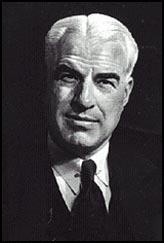|
(Paul Harris, from "My Road to Rotary" page 258)
During the war period
Rotary clubs not only met and served their countries and mankind, they not
only responded to the challenge of war, but farseeing Rotary leadership in
all lands knew the war eventually would come to an end. There was no
question but aggression would be repelled and freedom re-established. While
helping to accomplish this, Rotarians were giving thought to constructive
post war activities. The first world war opened our eyes to the futility of
emotionalism. Far more dependable grim determination has now taken its
place. There must be a better world organization than the League of Nations.
There must be less selfishness; more of the Rotary ideal of thoughtfulness
of and helpfulness to others.
So for several years Rotary
International has had a committee on post-war activities, studying the
problems that divide men and those that unite men and what must be
recognized in every country as the rights and the duties of its citizens.
This has been done so that Rotarians may be better prepared to make their
contribution to what must be done by mankind to prevent future wars.
During the past ten years hundreds
of Rotary clubs in the U. S. have conducted some two thousand institutes of
international understanding bringing to their communities hundreds of
capable speakers, from both the U. S. and various other countries, to
present and discuss before public audiences of from 200 to a 1000 people the
current factors of international affairs. The total attendance to date at
these institutes is something like 1,500,000. A fine accomplishment in adult
education! And in addition these speakers have been used to address
high-school assemblies totaling about 3,500,000.
Consequently it was not
surprising that Rotary International was invited by the United States
Department of State to send consultants and associate consultants to the
United Nations Conference on International Organization at San
Francisco in May, 1945, and in all eleven Rotarians served in one or the
other of these capacities.
258
The record indicates that they made a
very definite contribution to the thinking of the official delegates who
were charged with developing the charter. Edward R. Stettinius, Jr., who was
then Secretary of State of the United States, wrote:
| |
“The invitation to Rotary International
to participate in the United Nations Conference as consultant to the
United States delegation was not merely a gesture of good will and
respect toward a great organization. It was a simple recognition of the
practical part Rotary’s members have played and will continue to play in
the development of understanding among nations. The representatives of
Rotary were needed at San Francisco and, as you well know, they made a
considerable contribution to the Charter itself, and particularly to the
framing of provisions for the Economic and Social Council.” |
|
From "My
Road To Rotary" by Paul P. Harris, 1947
|
![[picture: Edward Stettinius leaving the White House, 1945]](trumanlib_stettinius_12-029.jpg)
Hear History
"This charter is a compact,
born of suffering and of war; with it now rests our hope for a good
and a lasting peace." (San Francisco, California, June 26, 1945)
|
| |
| Even before
celebrations for the end of World War II in Europe commenced,
delegates from fifty-one nations began a conference in San Francisco
to establish the United Nations, an international organization
designed to maintain peace and security in the postwar world.
Sixty-three days later, on June 26, 1945, the United Nations Charter
was signed. As early as 1942, the United States had proposed
establishing the world body, and in 1944 the groundwork was laid at
the Dumbarton Oaks Conference in Washington, D.C. The organization
was to possess considerably more authority over its members than the
defunct League of Nations, which had failed to prevent the outbreak
of World War II. Edward Stettinius, who was undersecretary of state
at the time, presided over that Allied meeting. A year later,
Stettinius, as secretary of state, served as chairman of the U.S.
delegation to the San Francisco Conference. Less than a week after
signing the U.N. Charter on behalf of the United States, he resigned
his cabinet post to become the U.S. representative to the United
Nations. The first meeting of the United Nations General Assembly
occurred on January 10, 1946, in London, England. |
 Stettinius,
Edward Reilly, Jr. Stettinius,
Edward Reilly, Jr.
1900-1949, American statesman and industrialist, b.
Chicago. He held (1926-34) several executive posts in the General Motors
Corp., and in 1938 he became chairman of the board of the U.S. Steel
Corp. He resigned (1940) as a business executive to join the National
Defense Advisory Commission. After serving as priorities director in the
Office of Production Management and as lend-lease administrator
(1941-43), he was (1943-44) Undersecretary of State and presided at the
Dumbarton Oaks Conference (1944). Succeeding (Nov., 1944) Cordell Hull
as Secretary of State, Stettinius attended the Yalta Conference and was
chairman of the U.S. delegation to the San Francisco Conference. He
resigned (June, 1945) his cabinet post and served (1945-46) as U.S.
representative to the United Nations. He wrote Roosevelt and the
Russians (1949). |

